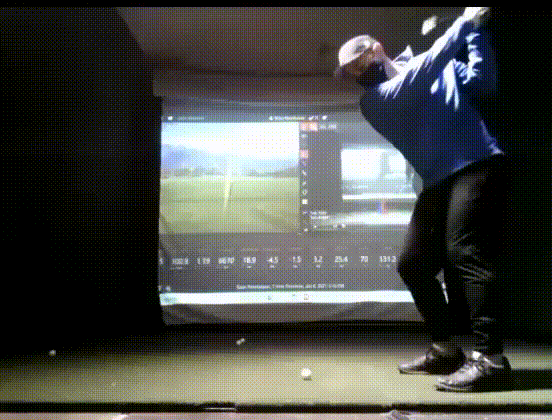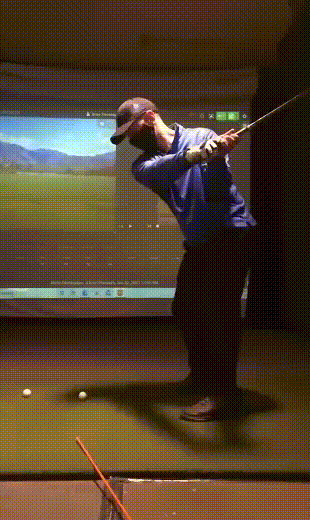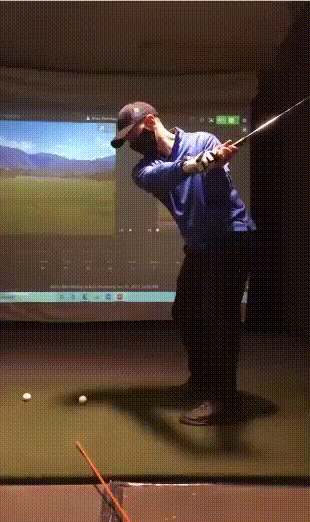It has been about six months since I decided to start a quest to reach scratch. I was probably a 20-25 handicap a year ago, and ended the season just under fourteen. My scores have been ticking lower, into the mid-80s, as I have begun to focus on my short game and putting. I can see a path to gaining at least another five strokes just through more improvement in those areas. There are fundamental problems with my standard swing, though, that are going to hold me back both in distance and consistency if I do not address them.
I sometimes practice at an indoor spot in Redmond that has Trackman tech to help me dial in and diagnose specific issues. One of the instructors that works there, Erin Menath, has caught my ear over time. Her first question to new students is, "What kind of learner are you?" She wants to know if the person learns best through feeling something, seeing something, or hearing something. Just that one question stood out to me after dozens of instructors I have seen. Her encouraging and gentle style also manages to be efficiently packed with wisdom. She does not overwhelm, but does not simply allow the time to pass without progress.
One of the most important aspects of assessing any instructor is whether they are truly invested in your success. They get paid whether you get better or not. The special ones are captivated by the challenge of teaching each unique person in front of them.
I decided to see if Erin could help me where other instructors have failed so far.
Ball flight
I hit a high ball. Too high of a ball. I lose at least 30% of potential distance (more on windy days) due to ball flight. I dream of hitting those low launch, piercing, shots that land at less than a 70 degree angle straight into the turf.
There are a variety of causes:
- My swing path is over the top
- I cast, or release the club too early
- I flip, or scoop with my trail hand, which adds loft to each club

This flip is something I'm also convinced is contributing to my golfer's elbow as my trail hand is constantly doing what amounts to a mini-curl while impacting a ball or turf on every swing.

You can see in the image above that I have lost my whole wrist angle before the club has even reached my hip.
My first lesson
Erin was friendly and matched my expectations in terms of persona and curiosity about my golf journey. She watched me swing for a bit, as I hit my 7 iron anywhere from 145-170 during warmups.
I was feeling a little cocky after having some of my best rounds in the previous week. That lasted all of five minutes.
Erin showed me my swing on video, and pointed out the same problems I have been hearing about for ages: casting, scooping, over the top. It was not surprising, but somehow still upsetting knowing that I continue to reinforce a bad swing, even if the results are improving.
She also called out something other instructors had not, which was that my hands were moving forward, toward my head at the top of my backswing, while I started my transition. This was a key initial symptom of a swing doomed to come in over the top.

Erin had me work on a few things. Collectively, they amounted to what felt like a total swing reconstruction. I was hitting grounders and could not even complete a full swing with any rhythm, but it also instinctively felt like the right direction, and I trusted her.
Step 1: Drop my hands
Instead of getting my hands moving forward on my downswing, she wanted them dropping down near my hip.

Step 2: Elbow in front of my body, pointing toward my belly
I had picked up the idea from somewhere that my trail elbow should pin down to my side during the transition on my downswing. Erin told me the elbow should actually be in front of my body, not on the side, and it should point at my belly button.
This felt super strange, and I don't have a great picture of it in action. This obviously helps to shallow the shaft.
Step 3: Make sure trail hand is hinged back
This was a big one. Maybe the biggest one that I was able to take with me. Remember my flat wrist from above?


Getting my hands down while maintaining that wrist angle gave me a chance to hit the ball without scooping. And there is no way to come over the top from down there.
I'll get to the turn in a moment.
Step 4: Twist the grip forward (and the club face down)
You will hear this everywhere. People talk about "knuckles down" and supinating the front wrist all the time. I have always struggled with the timing of this move and the feel of it.
I don't know if it's a physical thing for me, but twisting my wrist down is not super easy. I'd make a terrible motorcycle rider.
In any event, Erin wanted me to have the club face pointing straight up by the time my hands got down to my hips. It was too open.
Step 5: Shaft angle roughly 45 degrees to the ball
She wanted the butt of my grip to be pointing toward the ball when my hands were near my hip. You can see an orange alignment stick in some of the picks above that showed the general path angle.
Step 6: The turn
Once I got my hands down, my trail wrist hinged back, my front wrist twisted forward, and the shaft of my club at a 45 degree angle to the ball, I was ready to turn toward the ball.
I have always felt like I was swinging the golf club with my arms, like I did in baseball. This was a totally different feeling. The whole motion was driven by my hips, legs and shoulders. My arms and hands really just came along for the ride.
So clumsy. I was hitting ball after ball into the ground.

You can see my pumping my hands just to try and get a feel for where my hands were supposed to be. It was a lot of change to process, at least for my feeble brain and body.
The most important swing thought on the turn was really my back shoulder leading and going through the ball.
Step 7: Impact position
Erin reiterated multiple times that my trail wrist should retain its angle through impact. The whole concept of this swing pattern is to get the hands and wrists into the correct position and then really just turn your body through the ball. There are not a lot of moving parts.
Remember this?

Check out the difference below.

I have swung the club thousands of times trying to get that forward shaft lean and maintain some wrist angle. Erin helped me find it in a half hour.
Yes, the ball was going into the ground a lot, but the fundamentals were finally there.
Progress
I left the lesson nowhere near ready to play a round of golf. I was wondering if this was going to be months before I could really turn this new swing into something playable.
By the time I got home, I tried it again off mat on my deck into a net. I started to feel the club head a bit more through pressure on my trail pointer finger, and then I started getting a little bit more of a natural transition to the hands by my hips without needing to pump a few times.
The contact improved. I felt good enough that I went to the range the next day, and the results weren't awful. In fact, I was making more consistent contact with the sweet spot of my driver than usual. Distances were a little down, but it was feeling promising.
So I stupidly decided to play a round on Sunday. Not only did it work out okay, I shot my lowest score at Snoqualmie Ridge from the blue tees. My distances were mostly all down, but the swing and the contact were as consistent as they have ever been. If I had putted a little better and not rushed myself off the tee when a group allowed me to play through, I probably would have broken 80 for the first time in my life.

I plan to see Erin again this week and will keep the blog updated.
Remarkably, I had no idea Erin was as renowned as she is. Golf Digest named her one of the best young teachers in America this year. That might explain why she is incredibly hard to find time with. I'm glad I found her!

Comments